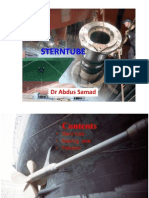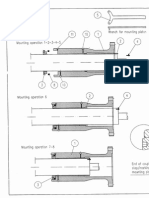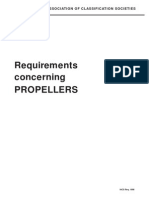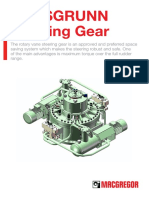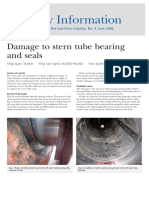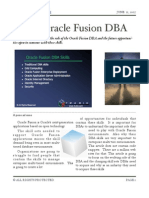0 ratings0% found this document useful (0 votes)
166 viewsStern Tubes
Stern Tubes
Uploaded by
weesweekwee86521) Stern tubes contain water lubricated bearings to reduce friction between the ship's propeller shaft and the stern. These bearings are typically made of lignum vitae wood.
2) Modern water tolerant oil lubricated stern tube bearings were developed to operate with high degrees of water contamination. These contain non-asbestos materials like Sternafe that are more tolerant of overheating and water contamination.
3) Oil lubricated stern tube bearings do not require a shaft liner. They generally have a small liner by the aft seal and are lined with white metal or reinforced plastics. Lubrication systems must maintain oil tightness despite temperature variations.
Copyright:
© All Rights Reserved
Available Formats
Download as DOC, PDF, TXT or read online from Scribd
Stern Tubes
Stern Tubes
Uploaded by
weesweekwee86520 ratings0% found this document useful (0 votes)
166 views8 pages1) Stern tubes contain water lubricated bearings to reduce friction between the ship's propeller shaft and the stern. These bearings are typically made of lignum vitae wood.
2) Modern water tolerant oil lubricated stern tube bearings were developed to operate with high degrees of water contamination. These contain non-asbestos materials like Sternafe that are more tolerant of overheating and water contamination.
3) Oil lubricated stern tube bearings do not require a shaft liner. They generally have a small liner by the aft seal and are lined with white metal or reinforced plastics. Lubrication systems must maintain oil tightness despite temperature variations.
Copyright
© © All Rights Reserved
Available Formats
DOC, PDF, TXT or read online from Scribd
Share this document
Did you find this document useful?
Is this content inappropriate?
1) Stern tubes contain water lubricated bearings to reduce friction between the ship's propeller shaft and the stern. These bearings are typically made of lignum vitae wood.
2) Modern water tolerant oil lubricated stern tube bearings were developed to operate with high degrees of water contamination. These contain non-asbestos materials like Sternafe that are more tolerant of overheating and water contamination.
3) Oil lubricated stern tube bearings do not require a shaft liner. They generally have a small liner by the aft seal and are lined with white metal or reinforced plastics. Lubrication systems must maintain oil tightness despite temperature variations.
Copyright:
© All Rights Reserved
Available Formats
Download as DOC, PDF, TXT or read online from Scribd
Download as doc, pdf, or txt
0 ratings0% found this document useful (0 votes)
166 views8 pagesStern Tubes
Stern Tubes
Uploaded by
weesweekwee86521) Stern tubes contain water lubricated bearings to reduce friction between the ship's propeller shaft and the stern. These bearings are typically made of lignum vitae wood.
2) Modern water tolerant oil lubricated stern tube bearings were developed to operate with high degrees of water contamination. These contain non-asbestos materials like Sternafe that are more tolerant of overheating and water contamination.
3) Oil lubricated stern tube bearings do not require a shaft liner. They generally have a small liner by the aft seal and are lined with white metal or reinforced plastics. Lubrication systems must maintain oil tightness despite temperature variations.
Copyright:
© All Rights Reserved
Available Formats
Download as DOC, PDF, TXT or read online from Scribd
Download as doc, pdf, or txt
You are on page 1of 8
Stern tubes
Water lubricated bearings
- The stern tube is normally constructed of cast iron slightly larger at the forward end to
ease removal. The forward end is flanged and bolted to a doubler plate stiffened aft peak
bulkhead. The forward end is supplied with a stuffing box and gland, the after end with a
bearing comprising lignum vitae or similar, the wood is dove tailed into a brass bush, the
wood is machined and cut on end grain. Can be lined with Lignum Vitae , rubber
composition cutlass rubber! or an approved plastic material Certain plastics possess
good bearing properties being inert and very tolerant of slow speed boundary lubrication
conditions. Cresylic resin bonded asbestos such as "ailco #$%&' give good results in
condition of heavy water contamination in the lubricating oil of almost (&&)!
*or water lubricated bearing not less than + x the diameter of the steel shaft. ,f the
bearing is over -%&mm diameter forced water lubrication must be used, a circulating
pump or other source with a water flow indicator.
The shaft is withdrawn for examination every - years.
Modern Water tolerant oil lubricated stern Tube
#ith the increase in si.e of VLCC/s shipping companies re0uired a stern tube bearing
capable of operating with high degrees of water comtamination. The alloys in white metal
tend to oxidise and the clearance is removed leading to sei.ure. ,n addition as shaft revs
reduced in search of improved propeller efficiency the hydrodynamic forces available
become limitedfor oil film generation.
*or this reason "ailco #$%&' bearings where developed.These contained a phenolic
resin impregnated asbestos yarn. The next generation contained non-asbestos material.
This material tended to be tainted due a series of overheating problems. later found due
to the combination of stiff high power transfer shafts and flexible hull design!.
The modern material is called 1tern1afe and comprises an inner bearing surface with an
overwound outerlayer. This has greater tolerance to overheating and reduced swell in the
event of water contamination. The latter allows for reduced running clearance and
thereby greater control of the shaft position reducing oil loss, seal damage and water
ingress.
$ wear gauge is incorporated into the bearing as our temperature sensors.
Oil lubricated bearings
2nlike for the water lubricated stern tube a shaft liner is unnecessary. 3enerally a small
one is fitted in way of the aft seal bolted on to the propeller boss. ,n this way it excludes
sea water contact with the main shaft and provides an easily replaceable rubbing surface
for the seal. Lined with white metal are to have a bearing length so as not to exceed a
bearing pressure from the weight of the shaft and propeller of 4 kg5cm6. The limitations
of a bearing are the load it can withstand without metal cracking or s0uee.ing out and the
temperature it can withstand without melting. Length of bearing not less than 6 7 8 in
any case. Cast iron and bron.e bearings must have a bearing length not less than +8.
Lubrication system must be capable of maintaining oil tightness despite varying
temperature. 3ravity tanks fitted with low level alarms, 2sual for aft peak to be filled
with water to provide cooling low suction valve to be fitted to be locked shut.
#ear down for the white metal should not exceed 6mm to avoid hammering out and the
period for inspection is 9 years. $ highly resilient reinforced plastic may be used in place
of the white metal. ,t is claimed to have greater load carrying capacity, high resistance to
fatigue and shock loading, with good lubrication properties. Ceramic liners can also be
used.
This system depends upon 'ydrostatic lubrication stern tube oil charge remaining in stern
tube until pressure test is carried put to ensure that oil supply line is not blocked. This is
done by manipulation of valves at header tank and operation of pump which slightly over
pressurises stern tube. :il returning to tank indicating clear oil lines. Top half of white
metal bearing is usually machined to give a left hand and right hand helix, this gives a
small pumping pressure forward to aft to provide lubrication and to assist in maintaining
oil tightness of the oil seals.
,f outboard seal leaks, the following steps are to be taken
(. *resh water in gravity tank to emulsify and coagulate it, oil pumped
around system to seal and lubricated.
6. "echarge with high viscosity oil
-. disconnect oil supply line and reconnect to +4 gallon drum which is
supported by block and tackle in order to give a variable head. ;y raising
and lowering the drum the oil pressure in the system can be made to match
the water pressure from outside taking into account the difference in
gravities.
#hen large propellers are fitted the heavy overhanging weight greatly increases the load
at the after end of the stern tube breaking down the hydrostatic lubrication causing metal
to metal contact and sei.ure towards the aft end of bearing. To obviate this it is usual to
angle the shaft downwards for about %mm over (&&m length thus attempting to ensure
than the weight of the bearing is taken on the full length of the bearing. ,t is good practice
to leave the oil tank open to the stern tube when in port with machinery stopped, this
prevents sea water leaking into the system. 'owever, water has been known to
contaminate lubricating oil systems causing rusting of tail shaft particularly when shaft is
stopped for periods long enough for water to settle in bottom of bearing. *it only water
seperator ,,e, a coalescer or cyclonic or osmosis system.
,n ships with large changes in draught it is usual to fit two gravity tanks. The upper tank
is used when fully loaded or there is water leaking in.
Water based oil replacements
$vailable are water based sterntube lubricants having the advantages of oil but with a
more eco-friendly face. These lubricants must have an ade0uate viscosity, resistance to
sea water contamination as well as biodegradability.
They typically have a water content greater than <&) and are highly soluble. *riction is
reduced in comparison to e0uivalent mineral oil5white metal bearing.
:ther benefits include increased heat transfer rates and better protection against galvanic
corrosion of dissimilar metals found in the shaft5prop arrangement.The fluid has no
measurable flash point.
Simplex shaft seal
$ very common arrangement for oil lubricated stern tube bearings. $ simplex seal
arrangement is fitted to both inner and outer ends.
The replaceable chrome liner prevents damage to the prop shaft which would be
expensive to repair.
=ot show is a rope guard bolt to the hull which prevents material from being /wound/ into
the gap and damaging the seal. "ope cutters may be fitted with a fixed blade attached to
the hull and a moving blade to the propeller.
:il pressure is fed to the area between the two opposite facing seals. This pressure is
governed by the draught of the vessel and is often supplied via tanks situated at set
heights. This pressure balances the sea water pressure on the seal and prevents sea water
ingress, by opening the correct tank the pressure exerted by the oil is insufficient to cause
oil to leakage out.
1tern tube seals with oil lubrication have tended to use rubber rings increasingly. *luoric
rubber Viton! with additives has been shown to be more effective than nitrile butadiene
rubber for seal rings
Fitting Shaft seals in service.
,t is possible to replace lip seals without removal of the tailshaft by vulcanising split seals
on the shaft.
The old seal is removed and the shaft and housing carefully cleaned
$ pre cut seal is assembled into the vulcanising machine
The vulcanising machine is then set up off the shaft and the position of the seal checked.
The vulcanising agent is mixed and applied to the seal ends.
The vulcanising machine is then fitted to the shaft and connected to an electrical supply.
$ heater within the machine heats the seal to a predetermined temperature for a set time
determined by ambient temperature, material type etc.
Split type stern tube (Rossturnbull!
>ain advantage of this system is that tail end shaft, stern tube bearing and tapped bolts
can be inspected without dry docking. 1ystem allows stern tube to be drawn into the
vessel for inspection
The bottom half bearing is supported on chocks which in turn rest on two ford and aft
machined surfaces within stern tube boss, these chocks govern the height of shafting. $
detachable arch is attached to the lower bearing and carries the outboard oil seal, the face
of which comes into contact with a seal seat which is fastened to and rotates with tail
shaft flange.
The top half of the bearing module makes a seal on the face of the arch and a seal along
the hori.ontal ?oint on the bearing. The bearing is held in place vertically by + x 4& tonne
pilgrim type ?acks, these ?acks also hold the two half bearings together. Lateral
positioning is by + x -&tonne pilgrim type ?acks, two each side.
$ running track is arranged above the bearing for easy removal of top half . $ rolled race
skid is provided so that the bottom half can be transported.
Removal-The hydro mechanical seal is actuated making a seal on the ford face of the
propeller and locked mechanically in position. The space is then drained of water.
Top half of bearing can then be removed by taking out the top vertical ?acks and using the
lifting ?ack to allow the top half to be brought inboard on the running track. These ?acks
are now fitted under the lower half bearing to raise bearing and shaft sufficient to allow
the chocks to be removed.
The ?acks are then lowered until the propeller rest on the propeller rest built into the stern
frame. *urther lowering allows the bearing to move away from the shaft until bearing is
resting on roller skids. The lower half bearing complete with oil seal can then be removed
into the vessel for examination.
"eversing the procedure enables the bearing to be replaced
Odd facts-$nti vibration locking gear fitted to ?ack nuts. $s with a C@@ it is usual to fit a
flange mounted propeller eliminating taper and keyway with there associated problems.
The tap bolts securing propeller to tail shaft flange can be removed one at a time, crack
detected and returned to their working position.
Stresses in tail shafts
8ue to the considerable weight of the propeller, the tail shaft is sub?ect to a bending
stress. There are however other stresses which are likely to be encountered. There is a
torsional stress due to the propeller resistance and the engine turning moment, and a
compressive stress due to the prop thrust. $ll these stresses coupled with the fact that the
shaft may be in contact with highly corrosive sea water makes the likelihood of corrosion
attack highly probable.
Axamining a tail shaft and stern tube
o ;efore the periodic inspection the bearing weardown should be measured.
o $fter shaft removed given thorough examination.
o :n water lubricated shafts the integrity of the fit of the bron.e liner should
be checked by tapping with a hammer along its length listening for hollow
noise indicating a seperation.
o >easure wear of shaft.
o Axamine key way for cracks especially the nut thread area.
o replace rubber rings
You might also like
- Stern TubeDocument24 pagesStern Tubevigambetkar100% (3)
- Stern TubesDocument46 pagesStern Tubesvivek100% (2)
- Rudder and Rudder Stock Inspection in DDDocument12 pagesRudder and Rudder Stock Inspection in DDJORGE100% (1)
- Framo Piping SystemDocument197 pagesFramo Piping Systemiyershashank100% (6)
- fV-Operator Manual PDFDocument28 pagesfV-Operator Manual PDFAbhishek KumarNo ratings yet
- SL2007 483Document7 pagesSL2007 483Subramoniam MarineNo ratings yet
- Laboratory 3 - Point Load TestDocument6 pagesLaboratory 3 - Point Load TestHusnina Mohd Noor20% (10)
- Va 502 PDFDocument59 pagesVa 502 PDFRodrigoNo ratings yet
- Stern Tube Oil PollutionDocument17 pagesStern Tube Oil PollutionRigel Nath100% (2)
- Stern TubesDocument9 pagesStern TubesArunNo ratings yet
- Group Oil Lub Stern TubeDocument25 pagesGroup Oil Lub Stern TubevivekNo ratings yet
- Sea-Water Lubricated Stern Tube BearingsDocument5 pagesSea-Water Lubricated Stern Tube BearingsfrancisNo ratings yet
- SKF CouplingDocument16 pagesSKF CouplingmatchutNo ratings yet
- Wartsila Water Lubricated Brochure v4 2Document7 pagesWartsila Water Lubricated Brochure v4 2Marlon Alejandro Arboleda TapiaNo ratings yet
- CP Propeller Equipment PDFDocument22 pagesCP Propeller Equipment PDFHtet Myat SoeNo ratings yet
- Man B&W Serv LTR Sl09-509-Sb-jDocument7 pagesMan B&W Serv LTR Sl09-509-Sb-jafsal999No ratings yet
- RT Flex 05Document12 pagesRT Flex 05George Domusciu100% (1)
- Reversing Gears of A Marine Diesel EngineDocument4 pagesReversing Gears of A Marine Diesel Engineashry_tarekNo ratings yet
- A Study On Torque Rich Phenomena in Ship OperationDocument11 pagesA Study On Torque Rich Phenomena in Ship OperationAnonymous XtvvG80zuNo ratings yet
- Alpha: Propeller Maintenance Concept Type VBSDocument6 pagesAlpha: Propeller Maintenance Concept Type VBSEdgar Real ViúlaNo ratings yet
- Fi Chier 0005Document7 pagesFi Chier 0005Anthony MayNo ratings yet
- X Engines PDFDocument13 pagesX Engines PDFAnonymous QMfx2I100% (2)
- MT Mosunmola Stern Tube Seal Service Report FinalDocument10 pagesMT Mosunmola Stern Tube Seal Service Report FinalNevzat AlkoçNo ratings yet
- Becker Rudder BladeDocument38 pagesBecker Rudder Bladedwi maryadi100% (1)
- Slow SteamingDocument3 pagesSlow SteamingArun SNo ratings yet
- Propeller PushupDocument7 pagesPropeller PushupMannMannNo ratings yet
- Alpha CP Propeller 2010Document29 pagesAlpha CP Propeller 2010blahblah8888100% (1)
- Guidelines - CE 2EDocument14 pagesGuidelines - CE 2ESUNILNo ratings yet
- March 11, 2016 News Hound: Engine Crankshaft Deflection MeasurementDocument11 pagesMarch 11, 2016 News Hound: Engine Crankshaft Deflection Measurementiwan ridwanNo ratings yet
- RT-91 Pressure Retaining Valve in Servo Oil Return PipingDocument6 pagesRT-91 Pressure Retaining Valve in Servo Oil Return PipingcataNo ratings yet
- Porsgrunn Steering GearDocument4 pagesPorsgrunn Steering GearPedro EscarráNo ratings yet
- REEDS - BOILERS - PAGES 01 To 40Document40 pagesREEDS - BOILERS - PAGES 01 To 40Narendra niranjan MathiyarasuNo ratings yet
- Crankcase ExplosionsDocument8 pagesCrankcase Explosionsazeezur100% (1)
- Typical Wear Mechanism 2 Stroke Exhaust ValvesDocument5 pagesTypical Wear Mechanism 2 Stroke Exhaust Valvesdragoscod100% (1)
- Operation & Maintenance Manual: For MP/01425.M4NH-OMMDocument118 pagesOperation & Maintenance Manual: For MP/01425.M4NH-OMMПавел100% (2)
- Adjustments of Fuel Oil SystemsDocument16 pagesAdjustments of Fuel Oil SystemsndlongndNo ratings yet
- Air Start ExplosionDocument12 pagesAir Start ExplosionsahilimuNo ratings yet
- 1 Stern Tube PrincipleDocument3 pages1 Stern Tube PrincipleKo Gyi BakaNo ratings yet
- Lagersmit Supreme SealsDocument6 pagesLagersmit Supreme SealsAdi MuhibNo ratings yet
- Propeller CrackDocument22 pagesPropeller CrackArdhika Hermigo100% (1)
- Connecting Rod B.E. BoltsDocument16 pagesConnecting Rod B.E. BoltsAnjaana PrashantNo ratings yet
- Damage To Stern Tube Bearing and SealsDocument4 pagesDamage To Stern Tube Bearing and SealsJoão Henrique Volpini MattosNo ratings yet
- Case Study 5Document5 pagesCase Study 5stopless_dalian685No ratings yet
- Data PDFDocument30 pagesData PDFBernardo Ramos Rojas100% (1)
- 08 Exhaust ValveDocument66 pages08 Exhaust ValveSky R100% (1)
- MAN ShaftErrosion SL2008-498Document18 pagesMAN ShaftErrosion SL2008-498flipflop12100% (1)
- MAN SL2018-659 - JAP (2018.03) - Cerment-Coated Piston Rings For Low-Sulphur Fuels (0.5% or Lower)Document9 pagesMAN SL2018-659 - JAP (2018.03) - Cerment-Coated Piston Rings For Low-Sulphur Fuels (0.5% or Lower)GrandpaNo ratings yet
- Marine System Design ProjectDocument243 pagesMarine System Design ProjectRishi Sashank100% (1)
- Man B&W 6S60MC 710Document17 pagesMan B&W 6S60MC 710Ishan Bhatnagar100% (1)
- 2008 MAN Exh Gas Emission ControlDocument31 pages2008 MAN Exh Gas Emission ControlFlo MarineNo ratings yet
- MB 3 MaintenanceDocument625 pagesMB 3 MaintenanceArjun MenonNo ratings yet
- Load DiagramDocument26 pagesLoad DiagramnareshNo ratings yet
- Ship Propeller Shaft Mounting ExplainedDocument2 pagesShip Propeller Shaft Mounting ExplainedmavericksailorNo ratings yet
- AR01 Main Marine Engine Crankshaft Failure Analysis - A Case StudyDocument8 pagesAR01 Main Marine Engine Crankshaft Failure Analysis - A Case StudymaddogoujeNo ratings yet
- BookDocument28 pagesBookFebrian Wardoyo100% (1)
- Service Bulletin RTA-46Document12 pagesService Bulletin RTA-46Christopher Garcia100% (1)
- Rta 70Document6 pagesRta 70George Domusciu100% (1)
- Marflex Deepwell Pump Brochure v3Document7 pagesMarflex Deepwell Pump Brochure v3Stathis MoumousisNo ratings yet
- Pull and Push Up of PropDocument11 pagesPull and Push Up of Propsandeep_yadav_530% (1)
- Vent Dispersion CalcDocument9 pagesVent Dispersion CalcPeddy Nesa0% (1)
- 3.1.1 Project Goals: 3.1.2 The Environment Impact Assessment (EIA)Document39 pages3.1.1 Project Goals: 3.1.2 The Environment Impact Assessment (EIA)Niroshani RajapakshaNo ratings yet
- Sound Pressure Meter (08-4c4)Document10 pagesSound Pressure Meter (08-4c4)Sri Krishna RakeshNo ratings yet
- Lighting Tower 3TNV76Document288 pagesLighting Tower 3TNV76rezandriansyahNo ratings yet
- Synthesis of Nickel Ferrite Nanoparticles by Co-Precipitation Chemical MethodDocument5 pagesSynthesis of Nickel Ferrite Nanoparticles by Co-Precipitation Chemical MethodFatma MaharaniNo ratings yet
- LH135E-4JE-22 R134a t0 - 15 Tamb 30Document4 pagesLH135E-4JE-22 R134a t0 - 15 Tamb 30Caio CesarNo ratings yet
- The Oracle Fusion DBADocument7 pagesThe Oracle Fusion DBAPavan PeriNo ratings yet
- 01 Double Pitch Roller ChainsDocument1 page01 Double Pitch Roller ChainsyerandasNo ratings yet
- Cookbook For BEx MigrationDocument12 pagesCookbook For BEx MigrationKiss János100% (1)
- JML Profile PDFDocument64 pagesJML Profile PDFmuhamadrafie1975No ratings yet
- Lighting Fixing DetailDocument1 pageLighting Fixing DetailPrasanna AbeysekaraNo ratings yet
- Cip 3056 ADocument5 pagesCip 3056 ARavneel ChandNo ratings yet
- 43Z PumpDocument454 pages43Z Pumpthuan86% (14)
- Beginner's Guide To Structural AnalysisDocument20 pagesBeginner's Guide To Structural Analysisricosanojuan100% (1)
- Carrier SplitDocument4 pagesCarrier SplitWissam JarmakNo ratings yet
- Service Manual Multizone RAM 60QH4 enDocument157 pagesService Manual Multizone RAM 60QH4 enRazvan StancescuNo ratings yet
- Translucent DatabaseDocument17 pagesTranslucent DatabaseAkshith GunasekaranNo ratings yet
- LTE iNFO PDFDocument44 pagesLTE iNFO PDFporwal_vivekNo ratings yet
- Apple Color StyleWriter 2400 Service SourceDocument158 pagesApple Color StyleWriter 2400 Service SourceDaniele MocciNo ratings yet
- Assignment IDT - GIFT Smart CityDocument3 pagesAssignment IDT - GIFT Smart CityAnshuman SahooNo ratings yet
- 05 RP - Process Know HowDocument25 pages05 RP - Process Know Howaff bear100% (2)
- 2 - N12-A100-A000-00 Vol 5 - List of DrawingsDocument1 page2 - N12-A100-A000-00 Vol 5 - List of Drawingsdaisy anenaNo ratings yet
- CMG Cap 1000Document40 pagesCMG Cap 1000savio77No ratings yet
- Is 4720 1982 PDFDocument14 pagesIs 4720 1982 PDFsuryakantNo ratings yet
- Carpet Floorring-Method StatementDocument6 pagesCarpet Floorring-Method StatementMuhib sadeddeinNo ratings yet
- GHMC Relaxes Norms For Structural EngineersDocument2 pagesGHMC Relaxes Norms For Structural EngineersRamaprasad VarmaNo ratings yet
- User Manual Jamicon 3vaav eDocument15 pagesUser Manual Jamicon 3vaav ematwan29No ratings yet
- 775 Sap BW Startup WorkshopDocument111 pages775 Sap BW Startup Workshoprohit sharmaNo ratings yet
